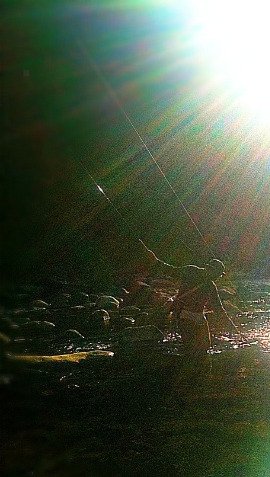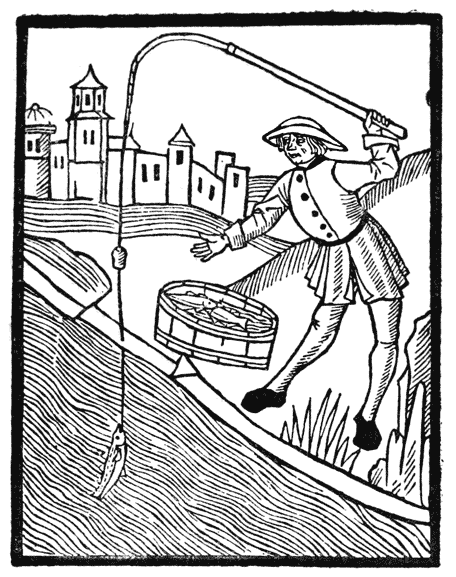Hair-Brained
Hair-Brained will be a section of TenkaraBum.com devoted to horsehair lines and to a lesser extent, horsehair-bodied flies. Please do not forget the hyphen - otherwise you might end up at beauty salon or barbershop sites. Careful, they might be clip joints.
 Fishing with a Horsehair Line
Fishing with a Horsehair LineMy interest in horsehair lines is older than my interest in tenkara. Actually, searching for information on horsehair lines is what led me to tenkara, and a fair amount of my Horsehair Lines page was written in 2010, within just a few months of starting the TenkaraBum.com website. I suspect many anglers would view my interest (obsession?) with fishing a horsehair line as hair-brained. Thus the name.
It all started with a fly. A North Country Spider. I don't remember the pattern, but I do remember the elegant simplicity. At the time, it was the most beautiful fly I had ever seen. I wanted to learn all I could about it - how to tie it and how to fish it. It didn't take long to realize there's a lot more information about how to tie North Country Spiders than there is about how to fish them. That's especially true with respect to how they were fished way back when they were first developed.
My research started with The Treatysse of Fysshynge Wyth an Angle, which is generally regarded as the earliest book on fly fishing. After all, if you're going to start, start at the beginning.
 Fysshynge Wyth an Angle
Fysshynge Wyth an AngleThe Treatysse has a fairly detailed section on how to make a horsehair line. I have copied a portion of it below:
"Now must ye make youre lynes in this wyse. Fyrste loke that ye haue an Instrument lyke vnto this fygure portrayed folowynge. Thenne take your heer & kytte of the smalle ende an hondfull large or more/ For it is neyther stronge nor yet sure. Thenne torne the toppe to the taylle eue ryche ylyke moche. And departe it in to thre partyes."
It goes on from there, but you get the drift.
 Instrument for Wyndinge Heer
Instrument for Wyndinge HeerAfter tying horsehair lines for over a dozen years now, I think I finally understand how that instrument works!
Somewhere there had to be instructions written in new English rather than Olde English. Researching horsehair line on Google eventually led me a Japanese site about tenkara because early tenkara lines were made from horsehair. Eventually I found a site that described in simple terms how to knot the ends of a few hairs together, twist them so they looked a bit like a three-ply rope and would stay together, and knot the other ends so they wouldn't come apart.
That section of line, the length of one horsehair (less a bit off each end for the knot and tag ends), is called a "snood." Tying snoods together forms a line long enough to fish with. Varying the number of hairs in each snood gives you a tapered line.
Well, it didn't take me long to buy some horsehair, tie up a line and give it a go. The first line I made, based on the number of snoods and number of hairs per snood specified on one of the Japanese websites, cast like a bullet! Wow! I actually had to make a second line with fewer hairs to get a line that was comparable in weight and performance to a modern tenkara line.
I've been playing around with horsehair tenkara lines ever since. I've also tied a few flies with horsehair as a body material and have done really quite well with them. This section of TenkaraBum will be more about tying and fishing horsehair lines lines than about the horsehair flies, but the flies were too good to omit.
I'm sure I'll write a bit about flies tied in a style that is vaguely reminiscent of North Country Spiders, but there has been so much written about North Country Spiders already, by people who know so much more than I do, that I will probably stick to something somewhat similar and let it go at that. I have too many years as a tenkara angler, and most historical tenkara flies didn't even have names, let alone recipes that called for specific feathers plucked from specific spots on specific birds' wings. Anyway, Pearsall's Gossamer silk thread is no more.
Expect yarn bodies (love yarn bodies). But skinny yarn bodies, really skinny. I remember once going to a presentation given by John Shaner (who truly is an authority on North Country Spiders). At one point he said something like "The bodies are very slim. Don't tie them like this..." and he then showed a slide of a fat-bodied fly that was the spittin' image of a Killer Kebari. Ouch!
Hair-Brained? Guilty as charged. Come on in, the water's fine.
What's next?
Hair-Brained will start out concentrating on horsehair lines, but I suspect in time it will circle back around to the elegantly simple flies of the North Country style and how best to fish them. No greenheart "loop rods" and certainly no modern fly rods and reels, but instead long rods with horsehair lines tied to the rod tip, which David Webster, W. C. Stewart, Isaac Walton, Charles Cotton, and even Dame Juliana herself would recognize as proper.
I'm not sure where this will end up, but one thing I am sure of - it won't be tenkara as it is understood by the Japanese masters or the American purists. I think it'll be fun, though.
TenkaraBum Home > Hair-Brained
“The bitterness of poor quality remains long after the sweetness of low price is forgotten” - Benjamin Franklin
"Be sure in casting, that your fly fall first into the water, for if the line fall first, it scares or frightens the fish..." -
Col. Robert Venables 1662
As age slows my pace, I will become more like the heron.
Warning:
The hooks are sharp.
The coffee's hot.
The fish are slippery when wet.
Beware of the Dogma
Currently processing orders that were received Mar 8.
This Just In
Horsehair Lines
Small Stream Pesca a Mosca
Valsesiana


